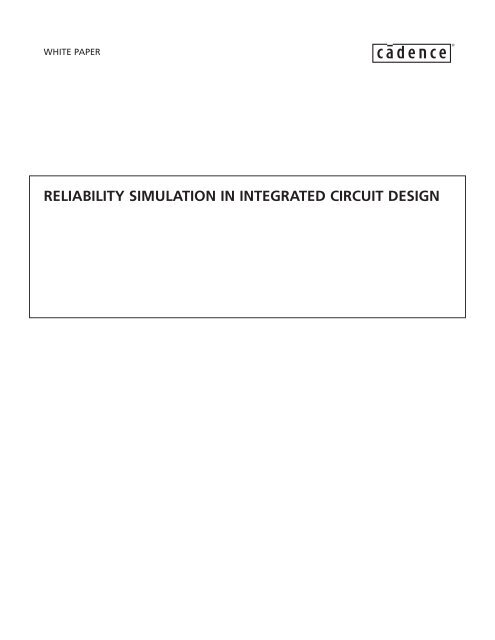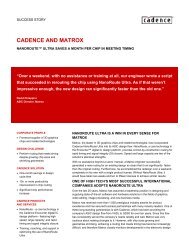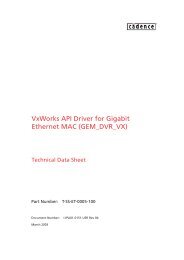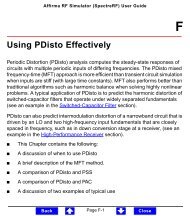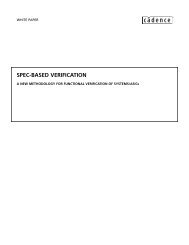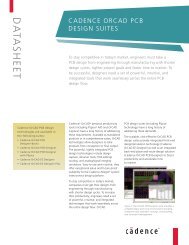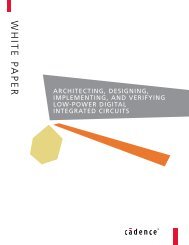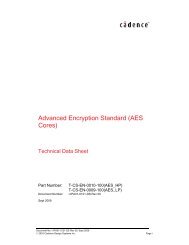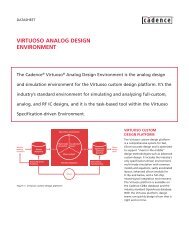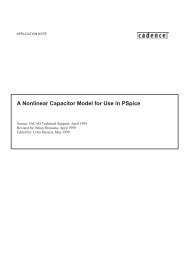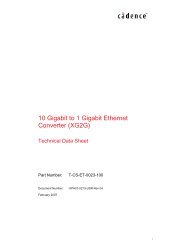Reliability Simulation in Integrated Circuit Design - Cadence ...
Reliability Simulation in Integrated Circuit Design - Cadence ...
Reliability Simulation in Integrated Circuit Design - Cadence ...
You also want an ePaper? Increase the reach of your titles
YUMPU automatically turns print PDFs into web optimized ePapers that Google loves.
WHITE PAPER<br />
RELIABILITY SIMULATION IN INTEGRATED CIRCUIT DESIGN
TABLE OF CONTENTS<br />
1 Abstract . . . . . . . . . . . . . . . . . . . . . . . . . . . . . . . . . . . . . . . . . . . . . . . . . . . . . . . . . . . . . . . . . . . . . . . . 1<br />
2 Introduction . . . . . . . . . . . . . . . . . . . . . . . . . . . . . . . . . . . . . . . . . . . . . . . . . . . . . . . . . . . . . . . . . . . . . 1<br />
3 HCI and NBTI . . . . . . . . . . . . . . . . . . . . . . . . . . . . . . . . . . . . . . . . . . . . . . . . . . . . . . . . . . . . . . . . . . . . 1<br />
4 Stress measurements . . . . . . . . . . . . . . . . . . . . . . . . . . . . . . . . . . . . . . . . . . . . . . . . . . . . . . . . . . . . . . 2<br />
5 Extraction and model<strong>in</strong>g . . . . . . . . . . . . . . . . . . . . . . . . . . . . . . . . . . . . . . . . . . . . . . . . . . . . . . . . . . . 4<br />
6 New flow . . . . . . . . . . . . . . . . . . . . . . . . . . . . . . . . . . . . . . . . . . . . . . . . . . . . . . . . . . . . . . . . . . . . . . . 5<br />
7 <strong>Reliability</strong> circuit simulation . . . . . . . . . . . . . . . . . . . . . . . . . . . . . . . . . . . . . . . . . . . . . . . . . . . . . . . . 6<br />
8 <strong>Design</strong> challenges . . . . . . . . . . . . . . . . . . . . . . . . . . . . . . . . . . . . . . . . . . . . . . . . . . . . . . . . . . . . . . . . 8<br />
9 Conclusion . . . . . . . . . . . . . . . . . . . . . . . . . . . . . . . . . . . . . . . . . . . . . . . . . . . . . . . . . . . . . . . . . . . . . . 8<br />
TABLE OF FIGURES<br />
Figure 1 HCI on NMOS . . . . . . . . . . . . . . . . . . . . . . . . . . . . . . . . . . . . . . . . . . . . . . . . . . . . . . . . . . . . . . 1<br />
Figure 2 NBTI on PMOS . . . . . . . . . . . . . . . . . . . . . . . . . . . . . . . . . . . . . . . . . . . . . . . . . . . . . . . . . . . . . . 2<br />
Figure 3 BSIMProPlus/RelProPlus and its measurement environment . . . . . . . . . . . . . . . . . . . . . . . . . . . 2<br />
Figure 4 Stress conditions setup . . . . . . . . . . . . . . . . . . . . . . . . . . . . . . . . . . . . . . . . . . . . . . . . . . . . . . . 3<br />
Figure 5 Measurement setup conditions dur<strong>in</strong>g the stress<strong>in</strong>g time . . . . . . . . . . . . . . . . . . . . . . . . . . . . 3<br />
Figure 6 Device degradation monitor Idl<strong>in</strong>, Idsat, Vt, and Gmmax parameters vs. the stress time . . . . 3<br />
Figure 7 NMOS extraction steps . . . . . . . . . . . . . . . . . . . . . . . . . . . . . . . . . . . . . . . . . . . . . . . . . . . . . . . 4<br />
Figure 8 PMOS extraction steps . . . . . . . . . . . . . . . . . . . . . . . . . . . . . . . . . . . . . . . . . . . . . . . . . . . . . . . . 4<br />
Figure 9 Lifetime model<strong>in</strong>g . . . . . . . . . . . . . . . . . . . . . . . . . . . . . . . . . . . . . . . . . . . . . . . . . . . . . . . . . . . 5<br />
Figure 10 <strong>Reliability</strong> model iterations for improvements . . . . . . . . . . . . . . . . . . . . . . . . . . . . . . . . . . . . . 5<br />
Figure 11 R<strong>in</strong>g oscillator schematic . . . . . . . . . . . . . . . . . . . . . . . . . . . . . . . . . . . . . . . . . . . . . . . . . . . . . . 6<br />
Figure 12 <strong>Reliability</strong> simulation with Virtuoso UltraSim or RelXpert . . . . . . . . . . . . . . . . . . . . . . . . . . . . 6<br />
Figure 13 Virtuoso UltraSim Full-chip Simulator GUI <strong>in</strong>side the Virtuoso Analog <strong>Design</strong> Environment . . 7<br />
Figure 14 Backannotation of the lifetime and degradation <strong>in</strong>to the schematic. . . . . . . . . . . . . . . . . . . . 7<br />
Figure 15<br />
Result of fresh and aged simulation us<strong>in</strong>g Virtuoso UltraSim Full-chip Simulator<br />
and displayed <strong>in</strong> AWD. . . . . . . . . . . . . . . . . . . . . . . . . . . . . . . . . . . . . . . . . . . . . . . . . . . . . . . . 8
1 ABSTRACT<br />
As gate oxide thickness and dimensions of scale shr<strong>in</strong>k <strong>in</strong> <strong>in</strong>tegrated circuit design, reliability problems<br />
occur and need to be considered early <strong>in</strong> the design process. Some of the more problematic issues <strong>in</strong>clude<br />
negative bias temperature <strong>in</strong>stability (NBTI) and hot carrier <strong>in</strong>jection (HCI). NBTI is a critical factor <strong>in</strong> PMOS<br />
devices and leads to current degradation, yield loss, and functional failure of <strong>in</strong>tegrated circuits. HCI has<br />
primarily effected NMOS devices, but today it is also a concern for PMOS devices. HCI is caused by hot<br />
carriers <strong>in</strong> the gate oxide that lead to oxide damages, which manifest themselves as current degradation,<br />
Vt shift, leakage current <strong>in</strong>crease, etc.<br />
Over time, both NBTI and HCI degrade device currents and will cause failures <strong>in</strong> <strong>in</strong>tegrated circuits. <strong>Circuit</strong><br />
designers need to consider these reliability effects <strong>in</strong> the early stages of design to make sure there are<br />
enough marg<strong>in</strong>s for circuits to function correctly over their entire lifetime. <strong>Cadence</strong> ® provides a complete<br />
solution, <strong>in</strong>clud<strong>in</strong>g reliability model extraction and calibration to silicon, with Virtuoso Device Model<strong>in</strong>g<br />
(BSIMProPlus) and full-chip reliability simulation and analysis with Virtuoso ® UltraSim Full-chip Simulator.<br />
2 INTRODUCTION<br />
CMOS technologies are constantly scaled down. For example, before the end of 2003, microprocessors will<br />
be produced on 90 nm processes, and production on 65 nm is planned for 2005. With the reduction <strong>in</strong><br />
geometries, the devices become more vulnerable to HCI and NBTI. With its recent acquisition of Celestry,<br />
<strong>Cadence</strong> offers the benefit of more than 8 years of experience <strong>in</strong> reliability model<strong>in</strong>g and circuit<br />
simulations <strong>in</strong> its flows. This paper presents an overview of this new reliability flow and offers suggestions<br />
to enhance HCI/NBTI circuit robustness.<br />
3 HCI AND NBTI<br />
With the geometric scale down, HCI and NBTI problems become worse. In the channel of the MOS, a high<br />
electrical field is created close to the dra<strong>in</strong>. The gate oxide thickness is also reduced to allow low<br />
threshold voltages. When the channel is conduct<strong>in</strong>g (Figure 1), the high electrical field close to the dra<strong>in</strong><br />
generates an <strong>in</strong>jection of hot carriers <strong>in</strong>to the (SiO2) gate oxide layer. This <strong>in</strong>serts charges <strong>in</strong> the oxide by<br />
trapp<strong>in</strong>g carriers (electrons and holes). These carriers can cause permanent changes <strong>in</strong> the oxide-<strong>in</strong>terface<br />
charge distribution.<br />
S<br />
G<br />
I<br />
g<br />
D<br />
n+<br />
n+<br />
P-well<br />
I sub<br />
impact<br />
ionization<br />
oxide<br />
damage<br />
Figure 1: HCI on NMOS<br />
1
This can also degrade the device’s dra<strong>in</strong> current capability. The accumulation of trapped charge will lower<br />
saturation current Idsat, cause Vt drift, lower the l<strong>in</strong>ear region transconductance, and degrade the<br />
subthreshold slope. As the geometry scales down, these problems become worse. Some IC manufacturers<br />
have already reported HCI problems for 0.5 um processes.<br />
NBTI is a critical effect <strong>in</strong> PMOS (see Figure 2). Some carriers damage the oxide, especially <strong>in</strong> processes<br />
where the oxide thickness is less than 50 angstroms. This is usually the case for 0.13 µ CMOS.<br />
S<br />
G<br />
D<br />
p+<br />
p+<br />
N-sub<br />
Figure 2: NBTI on PMOS<br />
4 STRESS MEASUREMENTS<br />
Virtuoso Device Model<strong>in</strong>g (BSIMProPlus/RelProPlus) automates HCI and NBTI stress and data collection<br />
through simultaneous control of various measurement hardware (see Figure 3). We can stress multiple<br />
devices at the same time.<br />
BSIMProPlus<br />
RelProPlus<br />
DC Source 1<br />
Probe station<br />
DC Source 2<br />
DC Source n<br />
I-V Meter<br />
Figure 3: BSIMProPlus/RelProPlus and its measurement environment<br />
2
We configure the devices we want to stress and we specify the bias stress conditions and the total<br />
stress time (see Figure 4).<br />
Figure 4: Stress conditions setup<br />
Dur<strong>in</strong>g stress, BSIMProPlus/RelProPlus can conduct the follow<strong>in</strong>g measurements, as shown <strong>in</strong> Figure 5:<br />
• Device IV curves, to observe how the device operation characteristics change over time.<br />
These collected curves will be used for the AgeMos model<strong>in</strong>g stage.<br />
• Degradation monitors. We observe the degradation of important circuit variables.<br />
Figure 5: Measurement setup conditions dur<strong>in</strong>g the stress<strong>in</strong>g time<br />
We see <strong>in</strong> Figure 6 that transistor degradation is a function of stress time. For these devices, we have four<br />
figures. For each of them the X axis is the stress time. Idl<strong>in</strong> and Idsat are decreas<strong>in</strong>g, Vt is <strong>in</strong>creas<strong>in</strong>g, and<br />
Gmmax is decreas<strong>in</strong>g.<br />
Figure 6: Device degradation monitor Idl<strong>in</strong>, Idsat, Vt, and Gmmax parameters vs. the stress time<br />
3
5 EXTRACTION AND MODELING<br />
For the NMOS, the extraction starts from the fresh model card (see Figure 7). We can start, for example,<br />
from exist<strong>in</strong>g BSIM3 or BSIM4 model cards. To these NMOS parameters we add some parameters for<br />
accurate Isub model<strong>in</strong>g. Us<strong>in</strong>g one of the monitor<strong>in</strong>g data measurements — Idsat or Idl<strong>in</strong> or Vt or<br />
Gmmax — we perform the lifetime extraction. The last step is AgeMos extraction. The AgeMos allows<br />
degradation models, which can run <strong>in</strong>to any SPICE-like simulators, for the aged simulation.<br />
Fresh model card<br />
Isub model<br />
Lifetime model<br />
HCI AgeMos model<br />
Figure 7: NMOS extraction steps<br />
For PMOS extraction, the difference is the addition of NBTI parameters extraction <strong>in</strong> the flow (see<br />
Figure 8). Gate current, <strong>in</strong>stead of substrate current, model<strong>in</strong>g may be used for age prediction.<br />
Fresh model card<br />
Isub/Igate model<br />
Lifetime model<br />
NBTI AgeMos model<br />
I-CI AgeMos model<br />
Figure 8: PMOS extraction steps<br />
The extraction of the lifetime parameters is easily performed. In Figure 9, we selected Idsat for lifetime<br />
monitor<strong>in</strong>g. The Idsat measurement shows that we have a current degradation versus the stress time.<br />
Idsat is a classical degradation monitor for digital applications. For analog application we usually prefer<br />
the threshold voltage Vt.<br />
4
Figure 9: Lifetime model<strong>in</strong>g<br />
The AgeMos model makes it possible to have degradation models based on the age calculated after the<br />
fresh simulation. The Virtuoso UltraSim Full-chip Simulator can use these models directly. To run aged<br />
simulation with other commercial simulators, such as the the Virtuoso Spectre ® <strong>Circuit</strong> Simulator, we will<br />
use a <strong>Cadence</strong> technology called RelXpert.<br />
<strong>Reliability</strong> model<strong>in</strong>g is an iterative process. Sometimes you need several iterations to get an accurate model,<br />
as shown <strong>in</strong> Figure 10.<br />
Fresh model card<br />
Isub/Igate model<br />
Lifetime model<br />
AgeMos model<br />
Yes<br />
Improvement<br />
End<br />
No<br />
Figure 10: <strong>Reliability</strong> model iterations for improvements<br />
6 NEW FLOW<br />
For many companies, the exist<strong>in</strong>g reliability flow is def<strong>in</strong>ed by rules: The reliability department def<strong>in</strong>ed<br />
reliability constra<strong>in</strong>ts that must not be violated by designers. Check<strong>in</strong>g the reliability of HCI/NBTI simulation<br />
is performed on the f<strong>in</strong>ished chip after burn<strong>in</strong>g the first prototypes. When failure occurs, a complete<br />
redesign must be done. The time-to-market of the circuits is delayed by six months or more…<br />
The new flow <strong>in</strong>troduces reliability circuit simulation <strong>in</strong> the circuit design phase, prior to layout.<br />
5
7 RELIABILITY CIRCUIT SIMULATION<br />
The traditional method to verify reliability models is to use a r<strong>in</strong>g oscillator. We have selected a r<strong>in</strong>g<br />
oscillator with n<strong>in</strong>e <strong>in</strong>verters. The schematic has been entered <strong>in</strong> the Virtuoso Schematic Editor<br />
(Figure 11).<br />
Figure 11: R<strong>in</strong>g oscillator schematic<br />
For the circuit simulation we can use one of two solutions — the Virtuoso UltraSim Full-chip Simulator or a<br />
SPICE-like commercial simulator such as the Virtuoso Spectre <strong>Circuit</strong> Simulator.<br />
INPUT SIMULATION OUTPUT<br />
Schematic<br />
SPICE netlist<br />
SPICE model<br />
<strong>Reliability</strong> param<br />
<strong>Reliability</strong> spec<br />
HSPICE, ELDO<br />
& Virtuoso<br />
Spectre<br />
RelXpert<br />
Virtuoso<br />
UltraSim<br />
• Device deg. table<br />
• Isub/Id table<br />
• Waveform comp.<br />
Fresh vs. aged<br />
BSIMProPlus<br />
&<br />
RelProPlus<br />
RelL<strong>in</strong>k<br />
Schematic<br />
Figure 12: <strong>Reliability</strong> simulation with Virtuoso UltraSim or RelXpert<br />
The SPICE-like simulator does not have HCI and NBTI simulation. In this case, we use RelXpert. RelXpert<br />
will drive the commercial SPICE-like simulator for the lifetime and degradation computations. RelXpert<br />
will generate a new netlist allow<strong>in</strong>g an aged circuit simulation.<br />
Virtuoso UltraSim offers the advantage of be<strong>in</strong>g a FastSPICE isomorphic simulator. It can easily handle<br />
larger circuits for mixed-signal and digital applications. For example, Virtuoso UltraSim can simulate<br />
memories like 1GB DRAM, with more than one billion transistors. The HCI/NBTI circuit simulation is built<br />
<strong>in</strong>side Virtuoso UltraSim. Figure 13 shows a snapshot of Virtuoso UltraSim Full-chip Simulator <strong>in</strong>tegration<br />
with the Virtuoso Analog <strong>Design</strong> Environment.<br />
6
Figure 13: Virtuoso UltraSim Full-chip Simulator GUI <strong>in</strong>side the Virtuoso Analog <strong>Design</strong> Environment<br />
With the reliability simulation we can:<br />
• Ask for the prediction of the age of each MOS <strong>in</strong>stance.<br />
• Request the simulator to predict degradation after several years of operation, for example 10 years, and<br />
also to generate degraded transistor models after 10 years of operation.<br />
• Request a lifetime prediction for each transistor, under the circuit operation condition, to reach a certa<strong>in</strong><br />
percentage of degradation. 10% degradation is a common request for reliability.<br />
• Select both HCI and NBTI at the same time, HCI only, or NBTI only, to get an aged simulation with<br />
degradation.<br />
In this simulation, comput<strong>in</strong>g the age of each MOS <strong>in</strong>stance is key <strong>in</strong>formation. For example, NMOS age is<br />
calculated with the follow<strong>in</strong>g formula:<br />
Age (t) =<br />
”(<br />
t<br />
I<br />
)<br />
sub ()<br />
o<br />
I ds<br />
()<br />
m<br />
I ds ()<br />
HW<br />
The simulator will pr<strong>in</strong>t out the degradation results <strong>in</strong> a table or with schematic backannotation<br />
(see Figure 14).<br />
<br />
Figure 14: Backannotation of the lifetime and degradation <strong>in</strong>to the schematic. In this example the lifetime is bad.<br />
7
This age <strong>in</strong>formation is used by the AgeMos to predict HCI and NBTI degradation, as shown <strong>in</strong> Figure 15.<br />
Figure 15: Result of fresh and aged simulation us<strong>in</strong>g Virtuoso UltraSim Full-chip Simulator and displayed <strong>in</strong> AWD.<br />
The period of the oscillator is <strong>in</strong>creased.<br />
Note: Virtuoso UltraSim and RelXpert can also be used as standalone products, outside the Virtuoso<br />
Analog <strong>Design</strong> Environment.<br />
8 DESIGN CHALLENGES<br />
HCI and NBTI <strong>in</strong>troduce a threshold voltage <strong>in</strong>crease for the MOS. This may be a real issue for mixedsignal<br />
applications. There is also a gm transconductance variation. This characteristic changes the ga<strong>in</strong> of<br />
transistors, which may not be expected by analog designers.<br />
With HCI and NBTI circuit simulation, designers can detect and locate potential issues.<br />
Because HCI is dependant of the horizontal electrical field <strong>in</strong> the channel, designers can improve the<br />
robustness of the devices by <strong>in</strong>creas<strong>in</strong>g their length. There is also an exponential decrease <strong>in</strong> hot carriers<br />
with a decrease <strong>in</strong> supply voltage. <strong>Design</strong>ers can change the bias conditions of the devices where the issue<br />
is found.<br />
NBTI problems are more difficult to fix. <strong>Design</strong>ers can check voltage overshoot to avoid the damage<br />
caused by NBTI. They may decide to <strong>in</strong>crease capacitive loads, <strong>in</strong>crease the transconductances, or reduce<br />
the supply voltage of the function to reduce NBTI susceptibility.<br />
<strong>Design</strong>ers should make it a priority to study the IO blocks of their designs. Creat<strong>in</strong>g robust HCI/NBTI<br />
circuits is a new challenge for digital/analog designers.<br />
9 CONCLUSION<br />
A complete flow allow<strong>in</strong>g digital and analog designers to compute HCI and NBTI reliability circuit<br />
simulation is available. <strong>Reliability</strong> circuit simulations are now possible: block reliability analysis can be<br />
conducted with RelXpert driv<strong>in</strong>g commercial simulators, and SOIC analysis is run with the new Virtuoso<br />
UltraSim Full-chip Simulator. HCI/NBTI reliability is a must for designs implemented with new processes.<br />
<strong>Reliability</strong> simulation needs to be implemented <strong>in</strong> PDK libraries located on the model<strong>in</strong>g stage. <strong>Cadence</strong><br />
offers a model<strong>in</strong>g service and can tra<strong>in</strong> the company model<strong>in</strong>g team on HCI/NBTI measurement and<br />
parameter extraction.<br />
<strong>Design</strong>ers need to learn to design for reliability and they should be educated on additional reliability<br />
analyses. The value is the reduction of failure and redesign costs.<br />
8
<strong>Cadence</strong> <strong>Design</strong> Systems, Inc.<br />
Corporate Headquarters<br />
2655 Seely Avenue<br />
San Jose, CA 95134<br />
800.746.6223<br />
408.943.1234<br />
www.cadence.com<br />
© 2003 <strong>Cadence</strong> <strong>Design</strong> Systems, Inc. All rights reserved. <strong>Cadence</strong>,<br />
the <strong>Cadence</strong> logo, Spectre, and Virtuoso are registered trademarks of<br />
<strong>Cadence</strong> <strong>Design</strong> Systems, Inc. All others are properties of their respective<br />
holders.<br />
#5082 12/03


